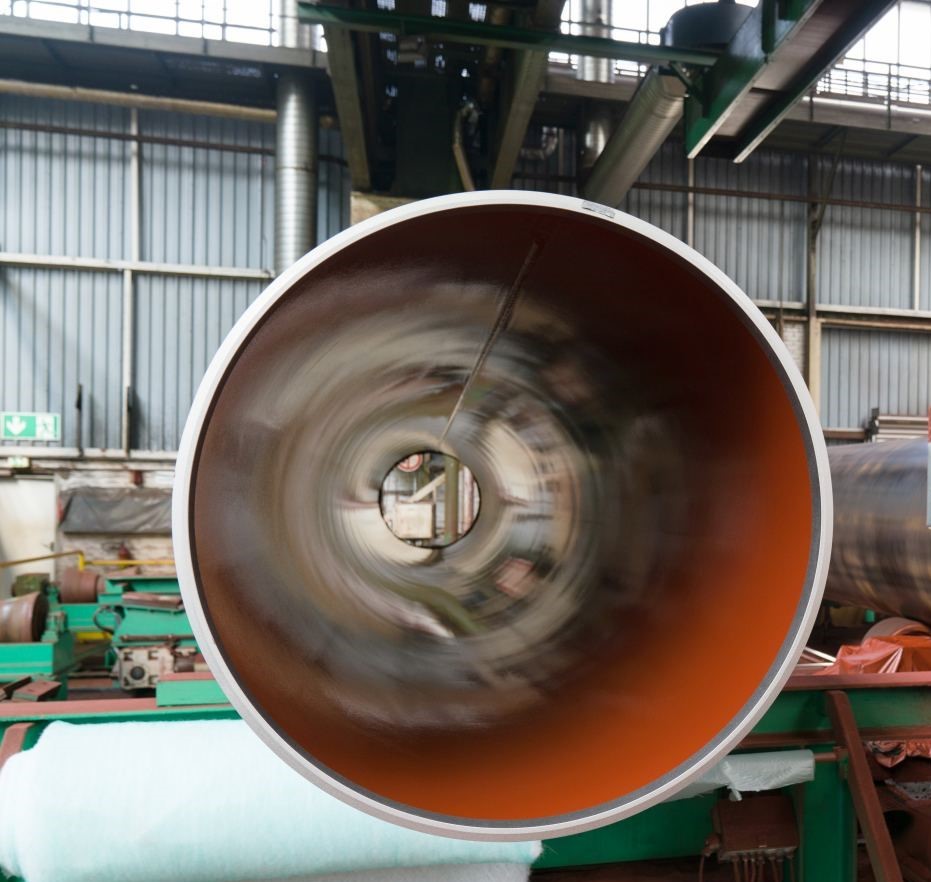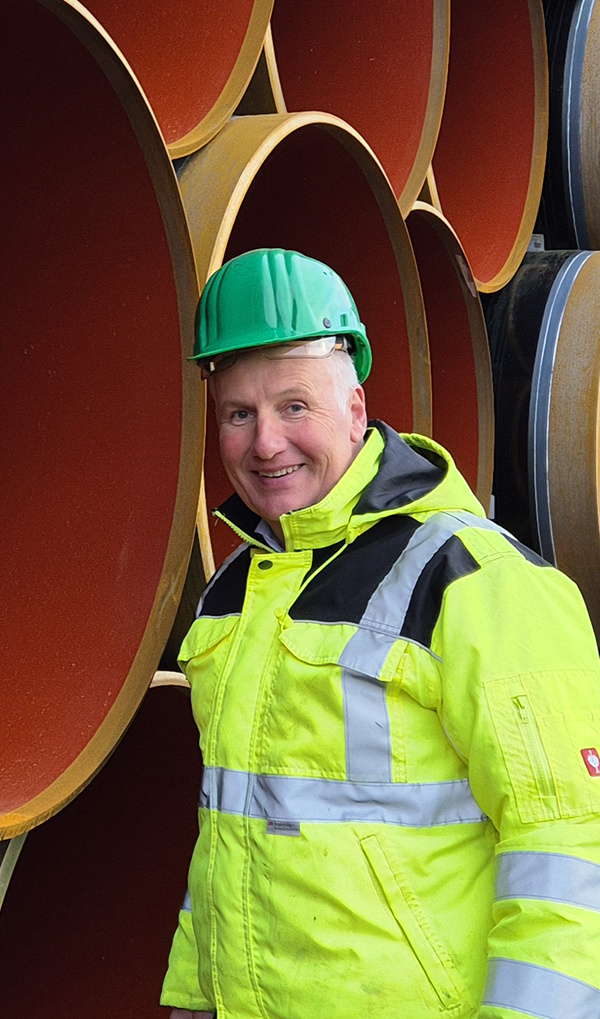Almost solvent-free internal pipe coating for gas and hydrogen pipelines
Mülheim Pipecoatings GmbH (MPC) operates the biggest ‘large-diameter pipe’ coating plant in the industry. With TEKNOPOX 3297, they have successfully converted their internal coating process to an almost completely solvent-free solution.
Less frictional resistance, more transport capacity, lower requirements for pressure increase and material thickness - Flowcoat internal coatings have a significant influence on the economic efficiency of gas pipelines. They also serve as temporary corrosion protection during storage and the construction phase. The coated inner pipe surface reduces the load on the filter systems in the compressor stations and simplifies cleaning before commissioning.
As a specialist and full-service provider for the surface treatment of pipes, Teknos has been offering flowcoats for gas pipelines for a long time. More than 10 million litres have already been produced and supplied to processors around the world. Customers include Mülheim Pipecoatings GmbH (MPC), one of the world's leading specialists in internal and external coatings for large-diameter pipes. MPC is a Europipe Group company and operates the largest coating plant in the large-diameter pipe industry, with an annual capacity of 9 million square metres of internal and external coating.
Avoidance instead of afterburning
MPC and Teknos are both pioneers in the development and use of virtually solvent-free flow coats. "We have been pursuing the goal of reducing and ultimately completely avoiding the use of solvents for a long time," explains Christian Balkenohl, Operations Manager at MPC. "This is not just about complying with official requirements. Employee and environmental protection are an essential part of our company philosophy, and environmental compatibility is also playing an increasingly important role for our customers."
The coating solutions from Teknos make an important contribution here. A first step towards reducing emissions was the Teknopox 3296 ultra-high-solid expoxy coating with more than 80 per cent volumetric solids content. The flowcoat was used in various major projects, among others. "By using ultra-high-solid coatings, we have already been able to significantly reduce the emission of volatile organic substances (VOC). However, the next step is the completely solvent-free production of the interior coating," says Christian Balkenohl.
The search for a solvent-free flowcoat was also fuelled by the stricter requirements of the Solvent Ordinance (31st BImSchV) and the implementation regulations (TA Luft). Emissions can either be retained by filter systems, disposed of by post-combustion or avoided from the outset. Thermal post-combustion in particular requires considerable effort, high investment costs and causes environmentally harmful emissions.

The challenge of reducing solvents
In the search for a suitable solution, Teknos was able to fulfil MPC's requirements in terms of application properties, process stability and solvent content. "Depending on the pipe dimensions, MPC coats up to 1,400 square metres of inner surface per hour," explains Christian Balkenohl. "With this application rate, the coating must cure so quickly that the line speed is not slowed down. Teknos has succeeded in developing a flowcoat that fulfils these requirements exactly. This provides MPC with a solvent-free flowcoat that is also suitable for large-scale production."
The solution is Teknopox 3297, an almost completely solvent-free two-component epoxy coating for the inner surfaces of pipework for non-corrosive gas. The flowcoat achieves a very smooth, mechanically robust surface and cures quickly. With a solids content of at least 97%, VOC emissions can be significantly reduced. The product has been tested in independent laboratories and fulfils the relevant standards such as API PR 5L2, EN 10301 and ISO 15741.
"The development of solvent-free coatings is a key focus at Teknos," explains Martin Mehler, Key Account Manager Teknos Germany. "In recent years, we have launched innovative solutions on the market in many application areas that drastically reduce emissions. Teknopox 3297 is a typical example of this. Achieving outstanding surface and process properties without the use of solvents is a major challenge that requires a lot of experience, especially when it comes to large coating volumes. It was an important milestone for us to be able to fulfil MPC's requirements with a virtually solvent-free flowcoat."
Launch after successful small series
A first major order with the solvent-free flowcoat was an offshore pipeline that was commissioned at the end of 2022 and transports natural gas over a total distance of 900 kilometres. In order to qualify the new internal coating for the first project, MPC subjected some of the pipes to 100 per cent sampling. Test coatings were applied in parallel operation on the production line to ensure that the solvent-free flowcoat was suitable for large-scale production. Much of the process remained the same. In some areas, such as pressures, nozzle size and nozzle spacing, details were adjusted. There was a difference in the application due to the higher viscosity of the solvent-free flowcoat. For this reason, MPC now uses temperature control units to ensure the required viscosity via the temperature setting.
Thanks to the adjustments, the required qualification for the project could be verified and the internal coating could be started in large-scale production. In the now completed project, a total of 92,216 metres of pipes with an internal surface area of 252,855 square metres were coated with Teknopox 3297 for the pipeline. Teknos supplied the flowcoat from its production facility in Germany not only in bulk containers, but also in cartridge form for repairs. This repair solution is the result of a joint idea by MPC and Teknos and makes it easier to apply the material during repair work.
Door opener for new projects
The impressive reduction in emissions thanks to the solvent-free flowcoat can be demonstrated by measuring the exhaust air flow. From an economic point of view, too, there is nothing to stop the new solution. Although the costs for the material are higher, there are savings in production. Firstly, material consumption is lower, because fewer litres of flowcoat are required per pipe with the same coating thickness. Secondly, the use of solvent-free material is considerably more economical than treating pollutants with a costly thermal post-combustion process.
"The first major project was a successful start to largely solvent-free production," summarises Christian Balkenohl. "The excellent collaboration with Teknos also contributed to this. Our leading role in environmentally friendly, solvent-free production was also a door opener for further major projects at MPC."
Future projects will also involve pipelines for transporting hydrogen
A study by Salzgitter Mannesmann Forschung (SZMF), one of the leading steel research institutes in Europe, recently confirmed that Europipe pipes coated with Teknopox 3297 at MPC are suitable for hydrogen pipelines in a 100 bar pure hydrogen atmosphere. This means that MPC and Teknos are ideally prepared for the pipeline projects of the future.

